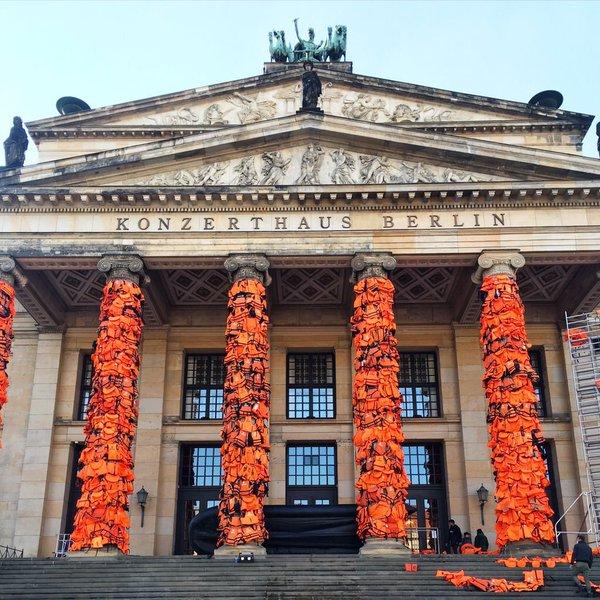
Ai Weiwei, art and activism
Giving the refugees a helping hand and a voice
Ai Weiwei 's activist art raises awareness for the refugee crisis in Europe. This paper looks at three of his projects in which he uses the social media in order to reach the public. These projects have received the media attention and critique to the way the refugee crisis is handled by Europe.
The controversial Chinese artist and activist Ai Weiwei currently lives in Europe while working on temporary exhibitions. The artist is known for his critique of the Chinese government for its lack of democratic procedures and violation of human rights. In 2011, he was placed under house arrest and his passport was taken away for 81 days (The Guardian, 2016). Nowadays, he is active with regard to the refugee crisis in Europe. He documents his experience on the social media such as Instagram, Facebook and Twitter.
Ai Weiwei's way of storytelling and reporting on the social media is innovative . In some way, very smart too.
Ai Weiwei's way of storytelling and reporting on the social media is innovative . In some way, very smart too, because he has apparently thought of how to reach a large public. He has repeatedly visited the Greek island Lesbos since the refugee crisis started. By doing so, he places himself in the middle of the 'refugee event'. Weiwei gives the refugees a helping hand when they arrive after their dangerous and traumatic travels. He also gives them a voice through his photos, videos and art installations.
In an interview with The Guardian (2016) Ai Weiwei has stated the following: :
‘The way I can protest is that I can withdraw my works from that country. It is very simple, very symbolic – I cannot co-exist, I cannot stand in front of these people, and see these policies. It is a personal act, very simple; an artist trying not just to watch events but to act, and I made this decision spontaneously’.
Two of Ai Weiwei's performances have attracted much media attention. Firstly, he closed his exhibition "Ruptures" in Copenhagen at Faurschou Foundation, in protest against a new law that allows the Danish authorities to seize valuables from asylum seekers and delay family reunions. The exhibition was supposed to end in mid-April (The Guardian, 2016). This occurrence has had some influence and attention in the media.
Secondly, he recreated the photo of the drowned three-year -old Syrian toddler Alan Kurdi by taking the pose of a drowned victim himself. The photo circulated on the social media, and people were very disturbed by it and the way Weiwei posed. Hamid Dabashi wrote in his opinion article for Aljazeera (2016) that Ai Weiwei the artist died in – and with – the fake death. That photo, perhaps, was his greatest work of suicidal art. The artist posing for the photograph in a similar position felt powerful, he said (CNN, 2016).
Life vests at Lesbos
There is a third object that I would like to put forward in order to focus on the artist's engagement. This is a project performed in Berlin. Tens of thousands of orange coloured life vests taken from beaches in Greece, where the refugees arrived from Turkey, are used to wrap them around the pillar of Berlin’s Konzerthaus.
The message spread was, obviously, to highlight the situation of the refugees trying to reach Europe.
Ai Weiwei draws attention to all the people who died during their travels, and in this regard he accuses Europe and the European Union of the manner they are handling the refugee crisis. The temporary art installation is an action for the Cinema for Peace Gala, which is held on Monday February 15th, 2016 (Konzerthaus, 2016).

Konzerthaus in Berlin
Let me focus a bit more on the object as it can be seen on a photo of the Konzerthaus. Somehow the object seems very appealing to me. The bright colour orange is screaming for help, attention, and may be considered as a warning as well. The vests are strangled together, as a mass: it shows how many people are victims, how many people risked their lives. Weiwei forces the spectator on his Instagram to look at the refugees as individuals.
We could imagine that the orange life vests are climbing up the pillars, just like people are doing in Ceuta and Melilla at the fences of the Spanish border. The vests are piling up and multiplying like the refugee crisis and its consequences. From a distance, the pillars look like the bars of a jail; the refugees are trapped in their situation, they are escaping their country and, at the same time, they arrive in Europe and get labelled as criminals. Trapped in a stereotype.
The Chinese artist is giving the refugees a voice with his art installations. He wants to provide them attention which they do not always get in the media. The way he does this reaches a broad public, but then we should be critical and think about which public he actually reaches. Probably, he does not reach the public which needs Ai Weiwei's insight the most.
References:
The Guardian (2016). Ai Weiwei shuts Danish show in protest at asylum-seeker law.
CNN Style (2016). Ai Weiwei poses as drowned Syrian child Alan Kurdi in photograph.
Konzerthaus Berlin (2016). Der chinesische Künstler Ai Weiwei erinnert mit einer Installation aus Schwimmwesten an Flüchtlinge.
Aljazeera (2016). A portrait of the artist as a dead boy.